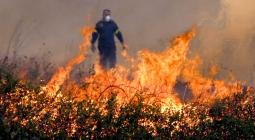Climate crisis: The 1.5C threshold explained

Y
You might have read it in news headlines in the run up to COP28, the UN climate talks held this year in Dubai, UAE. You might have heard it as part of your nation's climate pledge. You might know it from the Climate Clock in New York's Union Square, a public art project and reminder of the urgency of the climate crisis.
In any conversation about climate change, the figure "1.5C" is rarely far from the discussion.
But when people talk about "1.5C", what do they really mean? How do we measure it? And where did the figure come from? Is it the right target to be aiming for? And if we overshoot it, will we be able to come back below 1.5C again? Ahead of the climate summit in Dubai, we take a look at some of the questions around this key climate change figure.
What does keeping to the 1.5C threshold mean?
It means that by the year 2100, the world's average surface temperature will have risen to no more than 1.5C (2.7F) warmer than pre-industrial levels.
The 1.5C threshold was the stretch target established in the Paris Agreement in 2015, a treaty in which 195 nations pledged to tackle climate change. The agreement aims to limit global warming to "well below" 2C by the end of the century, and "pursue efforts" to keep warming within the safer limit of 1.5C.
"One-point-five has become an iconic figure," says Sir David King, former lead negotiator from the UK Foreign Office at the UN climate summit in Paris, 2015, which resulted in the adoption of the Paris Agreement.
Why 1.5C above "preindustrial levels"?
The main reason is that the industrial revolution was the time when Britain, followed by the rest of Europe, North America, Japan and other nations, began emitting large quantities of fossil carbon – carbon that would otherwise have remained locked up in oil, gas and coal deposits underground.
Industrialisation led to rapidly growing levels of greenhouse gases. These gases trap the energy from the Sun within the atmosphere, heating up the planet.
In the Paris Agreement itself, the baseline for pre-industrial measures wasn't defined. But the International Panel on Climate Change uses a baseline of 1850-1900. That's because it's the earliest period with reliable, near-global measurements. It's true that some warming from human activity had already occurred by that point, because the industrial revolution began in the early 1700s. But having good historical data for a reliable baseline is crucial to measure changes happening today.
The 1850-1900 baseline is one that scientists, politicians, policymakers, activists and everyone talking about climate change can use and be sure they are all referring to the same thing.
Where did the 1.5C limit come from?
The 1.5C "stretch target" in the Paris Agreement came as something of a surprise.
"I don't think anybody really thought that the Paris agreement would be that ambitious," says Myles Allen, professor of geosystem science at the University of Oxford, and a coordinating lead author on the IPCC's special report on 1.5C in 2018.
The 1.5C target was based on assessments of the impacts of climate change at different levels of warming. For instance, the IPCC report found that at this temperature, extreme heat is significantly less common and intense in many parts of the world than at 2C. And at the other extreme, the coldest nights at high latitudes warm by around 4.5C when the world is at an average of 1.5C warming. That figure is especially important for the future of sea ice in the polar regions. At 2C warming, the coldest nights warm by around 6C.
"Before the Paris Agreement there wasn't really a focus point for the world to aim for, to reduce the climate change process," says Pauline Dube, an environmental scientist at the University of Botswana, also a coordinating lead author on the IPCC's 1.5C report.
"To have had a situation where the world agreed on a target figure – that was a significant development in the climate change community."
Is 1.5C a safe level of warming?
In a 1.5C world, many of the deadliest effects of climate change are reduced. Sea level rise is expected to be around 10cm (4in) lower at 1.5C compared with 2C. However, irreversible melting of ice sheets on Greenland and Antarctica could be triggered between 1.5C and 2C, meaning that sea levels would continue to rise well beyond 2100. But it would happen more slowly at 1.5C than 2C, buying time for communities to adapt.
For small island nations and low-lying nations already seeing storms, rising sea levels and degradation of land and reefs, 1.5C would still pose an existential challenge. Loss and damage funding is seen as crucial for the long-term survival and adaptation of small islands and low-lying nations, as well as other nations especially vulnerable to climate change.
Compared with today, a 1.5C world would also be at increased risk of extreme heat, stresses on food production and access to water, and the range of insect-borne diseases such as malaria and dengue fever, among other threats.
The damage done at the 1.5C threshold also depends on how we get to 1.5C. If we overshoot 1.5C in the 21st Century and then reduce warming back to 1.5C (an "overshoot"), the risks are greater than if the world gradually stabilises at 1.5C. The peak temperature of the century will also have a big impact on the survival of ecosystems, such as tropical corals.
But have we not passed the 1.5C threshold already?
The year 2023 is on track to be the hottest on record. It brought the world's hottest July in 120,000 years, and September was also the hottest on record by a large margin.
The global average daily temperature was more than 1.5C more than the preindustrial average for roughly one-third of days in 2023. Needless to say, this was a record number of days above the 1.5C daily limit.
But there is a big difference between the global temperature on individual days, and the long-term average. The latter is what's meant when the 1.5C threshold is discussed in negotiations like COP28 – 1.5C warming is an average figure over a decadal time scale. This is a hard thing to measure, says Allen, and we know the global decade-to-decade average to within about a tenth of a degree at best.
Just as if you look at individual days rather than long-term averages, if you zoom in on particular regions of the world, we can also see that the 1.5C is being breached on local and regional levels.
The Arctic has warmed nearly four times faster than the rest of the world since 1979. Africa, too, warmed by around 0.3C per decade between 1991 and 2020, faster than the global average and faster than the 0.2C per decade in the 30 years before that.
When might we pass 1.5C on our current track and how will we know?
Earlier in 2023, the IPCC calculated that by the mid-2030s there would be a 50% chance of the world commiting itself to a rise of 1.5C. However, a new analysis taking into account more recent data suggests we could reach this threshold sooner – as early as 2029.
Because the IPCC uses long-term averages for the global temperature, we will pass 1.5C warming on individual days, months and years before the decadal average is considered to be past 1.5C.
And because of the difficulty in accurately estimating the global temperature from decade to decade, "it doesn't make too much sense to get hung up on exactly which year will cross 1.5C", says Allen.
Why do the estimates of when we will hit 1.5C warming change?
When countries introduce more – or less – ambitious policies for tackling climate change, the estimate for when that level of warming will be reached is adjusted too.
Changes to the estimate can also happen when new analyses of historical climate data help to refine climate models.
For instance, since the IPCC's 1.5C report, there has been one significant update since the report was published, Allen notes, which came when scientists re-analysed the historical record. The findings were that we are 0.2C warmer relative to preindustrial levels.
This doesn't change the big picture though. "You don't need a model to know that, if you are that close, we're going to reach 1.5C in around a decade or so at that rate of warming," says Allen.
How much worse is 1.5C than 1C, and how much better than 2C?
The difference between 1.5C and 2C is a whole lot worse than between 1C and 1.5C, says Allen.
"We know that the impacts get worse with warming – but we also know that the rate at which impacts get worse per degree also gets worse with warming," says Allen.
To put it another way, every tenth of a degree of warming matters, but as you get warmer each increment matters more.
"The reason we know this is because the world's ecosystems and economies were adapted to the climate of the late 19th and early 20th Century," says Allen. "That's the climate our ecosystems have been dealing with for the past few thousand years and it's the climate which our economies grew up with."
Are we going to overshoot 1.5C?
Overshooting 1.5C is "fast becoming inevitable", according to a report launched at COP28 by climate and social scientists.
The report, which aims to inform the leaders of the COP28 negotiations, says "minimising the magnitude and duration of overshoot is essential".
It's not just whether we go over the 1.5C threshold that matters, but how long we spend above that level of warming. The longer the world spends in overshoot, the greater the risk of passing crucial climate tipping points, and the greater the damage done to climate-vulnerable societies, ecosystems and economies.
To avoid overshoot completely, we would need to reduce emissions by 43% compared with levels in 2019.
Could we really come back from 1.5C?
Depending on how far we overshoot 1.5C, the answer is yes, says King.
"Overshoot is a terrible idea," says King, adding that rapid reduction in emissions now to avoid overshoot is by far the safest option. But as a backstop, it might be necessary so that we don't lose sight of a safe limit of warming altogether.
To get back below 1.5C after overshoot would require carbon capture on a massive scale. These technologies remove carbon from the atmosphere and store it in an inert form.
The Climate Crisis Advisory Group (CCAG), which King leads and which recently published a report on overshoot, puts the figure at between 10 and 15 billion tonnes of carbon dioxide per year – that’s 3-4.5 times more than the EU’s total greenhouse gas emissions in 2021, and about 2-3 times the US’s emissions in the same year.
To stand a chance of reversing overshoot, these technologies would need to be used in addition to eliminating the vast majority of new greenhouse gas emissions, notes King, not as a replacement for cutting emissions.
So far, these technologies exist only at a small scale, and they remain very expensive.
Even if we did return to temperatures under 1.5C after overshoot, many crucial systems would take centuries to return to a healthy state, including permafrost, sea levels, ice sheets and ocean acidity.
It would also be far more costly to overshoot 1.5C and then go back below the threshold than to avoid crossing it in the first place.
Is 1.5C the right target?
Given the extreme weather we are already seeing, some argue that 1.5C is not the final figure we should have in mind.
"CCAG is saying, 1.5C is already too high – look at what's happening today," says King. "And so we're saying, we will need to get it back down to less than 1C above the preindustrial level."
Even at 1.5C, the risk to crops could lead to a global food crisis and push us past crucial climate tipping points, such as Arctic ice melt and permafrost thaw. Instead, focusing on getting net temperature change to zero, and then into a period of cooling, could be a fairer approach, as policy analysts at the think tank Chatham House have argued.
Can we exploit new sources of fossil fuels and still meet the 1.5C limit?
Burning fossil fuels causes more than 75% of anthropogenic greenhouse gas emissions, and more than 90% of carbon dioxide emissions from human activites.
The fossil fuels produced from existing oil, gas and coal fields are more than enough to breach the 1.5C limit. Extracting fossil fuels from new oil and gas fields is incompatible with a 1.5C limit, according to a report by the International Institute for Sustainable Development and another by the International Energy Agency.
At present, governments are already planning to produce more than double the amount of fossil fuels than would be compatible with a 1.5C pathway. The UN's latest Emissions Gap report states that the world is on track for 3C of warming by the end of the century.
This is despite these projects coming with greater commercial risks and dwindling profits in the decades to come – if all of today's national climate goals are reached, private oil and gas companies would be worth 25% less than today. If the world gets on track for 1.5C warming, they would be worth 60% less.
Who thinks 1.5C is still viable, and who thinks it isn't?
Keeping 1.5C within sight would require rapid and unprecedented levels of action.
In terms of the picture the research paints, "that likelihood is almost like gone", says Dube.
Similarly, in 2022, Bill Gates said he saw "no chance" of the world staying within the 1.5C threshold, but believes innovation in climate technologies, such as forms of carbon capture, are promising solutions to climate change. In 2022, a number of media outlets declared that it was time to "say goodbye" to 1.5C.
But there has been pushback to these sentiments from figures including the IEA executive director Fatih Birol. "It is factually incorrect, and politically it is very wrong," Birol told the Guardian newspaper in 2022. "The fact is that the chances of 1.5C are narrowing, but it is still achievable."
For nations whose survival depends on keeping warming to levels as low as possible, 1.5C is also still front and centre of the debate. In an opinion article, journalist Amy Martin compares giving up on 1.5C to watching a fire you accidentally started burn, rather than trying to put it out.
"We're not doomed to a warming at 1.5C," says Allen. "It's very important to understand that it's still possible to limit warming to 1.5C, because we're not there yet."
Allen calculates that to fully abate the fossil fuel carbon dioxide emissions from 2022 would cost about $6tn (£4.7tn). "But, that said, we spent $13tn (£10tn) on fossil fuels last year. That was a year which was obviously affected by the Russian invasion of Ukraine, and so on, but it goes to show that the money is out there to fix the problem. It's just not being directed to solving the problem at the moment."
What are some promising signs of staying within 1.5C to look out for?
For King, strong leadership from the US and China is one of the most promising things he could see coming out of the COP28 climate summit.
"I believe it's critically important for the United States and China to first of all come forward with a strategy," says King.
King negotiated with the Chinese and US climate envoys in 2015, both of whom are still in post. The US and China recently released an agreement on climate action between the two countries.
"Now it doesn't go far enough, but nevertheless, what a wonderful start," says King. "I think it's critically important, because, frankly, if China and the United States come forward, the European Union will join them. I think India will join them and, with Lula (President Luiz Inácio Lula da Silva) in place in Brazil, I think Brazil will join them. And then everyone else will."
For Allen, it's a focus on the positive tipping points that can signal accelerated decarbonisation – such as the changes seen in the renewable power sector and uptake of electric vehicles.
For Dube, she is looking out for a shift in perspective that acknowledges the deep injustice that comes with climate change fuelled by the Global North, but felt most keenly in the Global South. That means signals that climate change is being tackled fairly, with adequate support for adaptation and loss and damage funding for climate-vulnerable nations.
"The crucial point of change is really to realise that we need a whole-society transformation," says Dube.
--






